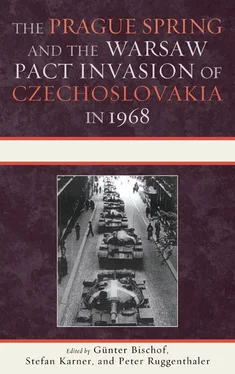The Cold War fortified Stalinist discourse and undercut any attempts to form a Russian national alternative to Stalin’s empire. Cold War propaganda strengthened the illiberal reactions and predilections of Russian society and elites. After all, the Soviet Union opposed the most radical liberal democracy of all, the United States. The Kremlin leadership successfully argued that cultural liberalization and ideological deviations could only hand powerful weapons to the enemy, and the loss of stability in the USSR and the loss of the Soviet empire in Eastern Europe would then be inevitable. The vast majority of the Russian ethnic “core” of the Soviet Union supported the center against the anti-Russian periphery (the Balts, West Ukrainians, and Georgians). An even greater majority of Russians, including the cultural-intellectual elites and students, strongly associated themselves with the Soviet victory in the Great Patriotic War. Faced with a choice between liberalization and the Soviet postwar empire, most of them chose the latter. “The hegemony over East Central Europe,” as one historian aptly remarked, “became the most visible and palpable prize of the great Soviet victory and therefore functioned as a powerful moral bond between the regime and its peoples and among the various sectors of the Soviet elite.” 20
Even worse, Russians were deeply divided among themselves on the meaning of de-Stalinization. In Western and dissident literature, the division between “Stalinists” and “anti-Stalinists” became the standard binary formula to analyze and discuss politics and cultural divisions during the Khrushchev period and in the post-Khrushchev years. Useful as it was, this formula nevertheless simplified motivations and feelings behind “Stalinist” and “anti-Stalinist” façades. Above all, it failed to explain the remarkable resilience and strength of “Stalinist” attitudes in the Soviet society, as well as the chronic weakness of the “anti-Stalinist” camp.
In Soviet Russia, Stalinism had cultivated powerful identities that outlived Stalin because they appealed to Russian historical memories, pride, and fears. For millions, the Stalinist past embodied three decades of incredible suffering, destruction and executions, torture and slave camps. Yet for other millions of Russians, Stalinism symbolized an era of unparalleled achievements, great upward social mobility, enthusiasm, and triumphs, including victory in World War II. Vladimir Kozlov discovered the widespread phenomenon of anti-Khrushchevian “popular Stalinism” that was illiberal and immune to the values of individualism and human rights. Many felt repulsed seeing how Khrushchev and other Soviet “bosses” distanced themselves from Stalin, while retaining their power and privileges and pretending they still had the right to lead and rule. In many regions of Russia, people believed that Stalin’s terror in 1934–1938 was retribution to Communist bosses who had oppressed the “common people” and brutally enforced collectivization. Finally, many people remembered Stalin as the indispensable wartime leader who had led the country to victory. 21
Even among intellectuals there was a curious attitude: anti -anti-Stalinism. They felt that Khrushchev’s denunciation of Stalin and the way he stifled any discussion in society was wrong and profoundly immoral. 22Writer Konstantin Simonov once told Khrushchev that his denunciation of Stalin was like reversing a car that was moving forward at full speed. “You have to stop first and switch gears. I believe we should take a timeout and think.” 23This kind of reaction reflected the traditional alienation between the regime and those who viewed themselves as the heirs to the left-liberal Russian intelligentsia of the nineteenth century and who experienced a profound feeling of social duty and moral responsibility.
Instead of presenting a credible alternative to Stalinist discourse, nationalism in Soviet Russia played a highly divisive role, putting sharp limits on de-Stalinization in Soviet Russian society. Stalin had successfully used the pre-revolutionary arsenal of the Great Russian imperial ideology to build up his cult. He also directed people’s discontent against the Jews. Late Stalinism revived and exploited Russian traditional identities, which had more in common with the prerevolutionary Black Hundred anti-Semitic nationalist movement than with Marxist-Leninist ideology. Many young intellectuals, ethnic Russians, imbibed anti-Semitism along with Great Russian chauvinism, and 1956 did not change their views. They became “Russian patriots” who hated liberals and cosmopolitan intellectuals, viewing their activities as treasonous.
Russian-Jewish intellectuals and cultural figures, victims of the anti-Semitic campaign, children of Old Bolsheviks and true believers in communism, were among the first who embarked on the process of de-Stalinization from below. They played a uniquely active role in the formation of the vanguard of cultural, intellectual, and spiritual liberalization. 24Most of them continued to perceive Stalinism as a deviation from the correct historical path, and from the legacy of the Russian revolution. The uniting discourse of this group was reform communism or “democratic socialism.” Educated as Soviet patriots, these people were shocked by the Soviet invasion of Hungary in 1956 and believed that principles were more important than the preservation of Stalin’s empire. The priority of these artists and intellectuals was cultural and intellectual emancipation, not traditional organized politics, and they rejected violence in the name of social change. A few them began to break with the faith of their Old Bolshevik parents, and some even became radical liberals, if not libertarians. They rejected the Soviet regime as a hostile force, and resented the official doctrine of socialist realism as a form of cultural oppression. Alexander Ginzburg, the father of samizdat , remarked to the writer V. Aksyonov in 1960: “It is a new environment where [the KGB] can no longer shadow all of us. There are just too many of us. This generation turned out to be like that, too many are marching out of lockstep.” 25
During the late 1950s and early 1960s, the rift deepened between “Russian patriots” and “liberals” (they gave different definitions to each other) inside the cultural elites, especially in the Writers’ Union. While similar tensions existed in Communist Poland, Hungary, and even in Czechoslovakia, there were also, at various historical moments, broad national democratic coalitions that included “Jews” and even had them play the key role as the adepts of liberal or reform Communist ideas. It did not happen in Soviet Russia. Before the Thaw, “Russian patriots” victimized “cosmopolitans”; during the Thaw, the latter tried to settle their score with the former in kind. The constant rivalry precluded the formation of any new brand of liberal democratic movement that could simultaneously appeal to Russian national feelings. The “Russian patriots” rejected the ideas of reform communism and liberal socialism as the manifestations of the cosmopolitan “Jewish” spirit, which they regarded as destructive for Russians. 26Members of the cultural vanguard of the early 1960s regarded Russian nationalism as a reactionary, anti-Semitic, and potentially “fascist” phenomenon. Both sides periodically looked to powerful allies in the Soviet party apparatus for support. 27
Against the background of these divisions, it is surprising that the ideas and values of the “third way,” “democratic socialism,” cultural liberalization, and economic reforms still played a prominent role in the Soviet Union in the years preceding the Prague Spring.
BIRDS OF SPRING: “PEOPLE OF THE SIXTIES”
Khrushchev’s de-Stalinization actions and the Thaw created an unusual phenomenon in Soviet society: a growing number of men and women, including many from the postwar cohorts of the “Soviet intelligentsia” and educated professionals as well as survivors belonging to the pre-Stalinist intelligentsia, began to think of themselves as an informal and nonpolitical community. In public life, many of these people were party members and Komsomol activists. Privately, however, they stood in aesthetical and ethical opposition to the bulk of the party-state nomenklatura and the country’s leadership, considering them uneducated, crude, and repulsive. At the core of this phenomenon was the rejection of Stalinism in favor of liberal humanist values and ideas of individual dignity, the rejection of the turgid canon of socialist realism, the faith in historical progress, and a youthful sense of opening horizons. The most common, if very loose, name for this community was “people of the Sixties” ( shestidesyatniki ). It implied not so much the generational change (although it was visible) as a cultural, ethical, and aesthetical distancing from the Stalinist past.
Читать дальше












